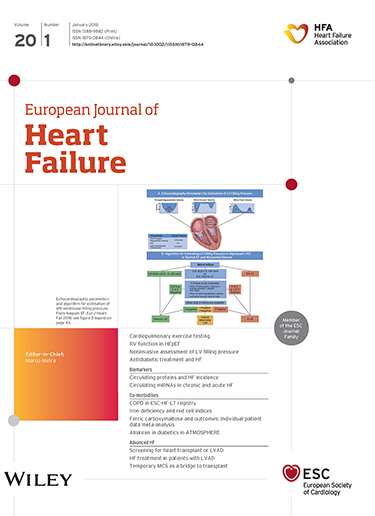左心室射血分数在心衰诊断和治疗中的应用。ESC心力衰竭协会(HFA)、美国心力衰竭协会(HFSA)和日本心力衰竭协会(JHFS)的临床共识声明
IF 16.9
1区 医学
Q1 CARDIAC & CARDIOVASCULAR SYSTEMS
引用次数: 0
摘要
这一临床共识声明重新审视了左心室射血分数(LVEF)作为心功能测量、预后标记和心衰患者分类的主要标准的作用,并为临床实践提供了新的建议。传统上,心力衰竭是根据LVEF阈值进行分类的,这对治疗建议具有重要意义。然而,LVEF测量的再现性较差,当其高于45%时,其预后和诊断价值降低,与心功能障碍的严重程度或更高值的结果无关。这些局限性表明,需要一种更全面的方法来分类和评估心力衰竭,更多地关注LVEF的发展轨迹,而不是其绝对值。此外,对于疑似新发心力衰竭且n端前b型利钠肽水平升高的患者,开始使用钠-葡萄糖共转运蛋白2抑制剂、矿皮质激素受体拮抗剂和利尿剂等治疗时,不需要评估LVEF。未来的研究利用先进的成像技术和生物标志物,可以更好地表征心肌结构、代谢和性能,可能有助于确定替代治疗靶点,并更好地监测LVEF全谱心力衰竭治疗。本文章由计算机程序翻译,如有差异,请以英文原文为准。
The use of left ventricular ejection fraction in the diagnosis and management of heart failure. A clinical consensus statement of the Heart Failure Association (HFA) of the ESC, the Heart Failure Society of America (HFSA), and the Japanese Heart Failure Society (JHFS)
This clinical consensus statement revisits the role of left ventricular ejection fraction (LVEF) as a measurement of cardiac function, a prognostic marker and a major criterion to classify patients with heart failure, and gives new advice for clinical practice. Heart failure is traditionally classified on the basis of LVEF thresholds and this has major implications for treatment recommendations. However, the reproducibility of LVEF measurement is poor and its prognostic and diagnostic value lessens when it is above 45%, with no relationship with the severity of either cardiac dysfunction or outcomes at higher values. These limitations dictate the need for a more comprehensive approach to classify and assess heart failure focusing more on the trajectory of LVEF rather than to its absolute value. Furthermore, the assessment of LVEF is not required for the initiation of treatments like sodium–glucose cotransporter 2 inhibitors, mineralocorticoid receptor antagonists and diuretics in patients with suspected de novo heart failure and elevated N-terminal pro-B-type natriuretic peptide levels. Future research utilizing advanced imaging techniques and biomarkers which can better characterize myocardial structure, metabolism and performance may facilitate the identification of alternative therapeutic targets and better ways to monitor heart failure therapies across the entire spectrum of LVEF.
求助全文
通过发布文献求助,成功后即可免费获取论文全文。
去求助
来源期刊

European Journal of Heart Failure
医学-心血管系统
CiteScore
27.30
自引率
11.50%
发文量
365
审稿时长
1 months
期刊介绍:
European Journal of Heart Failure is an international journal dedicated to advancing knowledge in the field of heart failure management. The journal publishes reviews and editorials aimed at improving understanding, prevention, investigation, and treatment of heart failure. It covers various disciplines such as molecular and cellular biology, pathology, physiology, electrophysiology, pharmacology, clinical sciences, social sciences, and population sciences. The journal welcomes submissions of manuscripts on basic, clinical, and population sciences, as well as original contributions on nursing, care of the elderly, primary care, health economics, and other related specialist fields. It is published monthly and has a readership that includes cardiologists, emergency room physicians, intensivists, internists, general physicians, cardiac nurses, diabetologists, epidemiologists, basic scientists focusing on cardiovascular research, and those working in rehabilitation. The journal is abstracted and indexed in various databases such as Academic Search, Embase, MEDLINE/PubMed, and Science Citation Index.
 求助内容:
求助内容: 应助结果提醒方式:
应助结果提醒方式:


